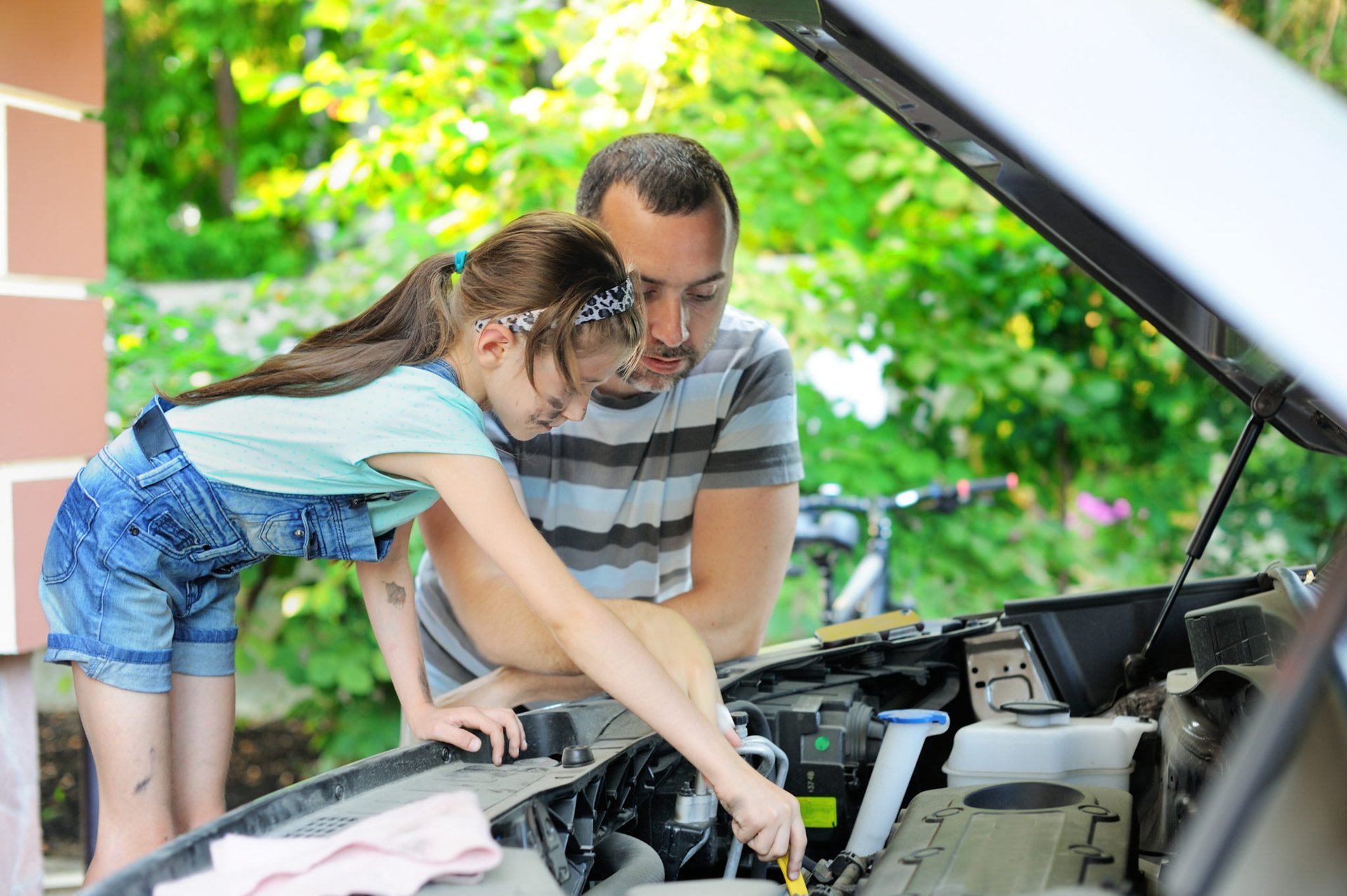
Car Maintenance 101: Teaching Teens Basic Auto Skills
Teaching teens to drive involves more than just the rules of the road. One important fact is that basic car maintenance knowledge is essential for their safety and independence. This blog post will guide you through teaching your teen essential auto skills, from checking oil levels to jump-starting a car. Keep reading to make sure your teen stays safe on the road.
Key Takeaways
- Teens learning to drive should also know how to maintain a car, including checking oil and coolant levels, ensuring they can safely handle the vehicle in various situations.
- Basic auto maintenance skills like jump – starting a car and understanding warning lights help teens become more independent and prepared for emergencies on the road.
- Regularly checking air filters, tire tread, and pressure, along with knowing how to change a tire and charge a dead battery are crucial skills that contribute to both the safety of the teen driver and the longevity of the vehicle.
- Empowering teens with auto maintenance knowledge not only boosts their confidence but also instills responsible driving habits that last a lifetime.
Basic Overview of a Vehicle
Understanding the basic structure and components of a vehicle is essential for teens learning to drive. A car consists of several key systems that work together to ensure it operates smoothly and safely.
The engine, often considered the heart of the automobile, powers the vehicle. It requires regular oil changes to maintain its efficiency and prevent damage. The braking system, including brake pedals and pads, ensures the car can stop effectively when needed.
Vehicles also come equipped with an HVAC system for heating, ventilation, and air conditioning to keep passengers comfortable in all weather conditions. The electrical system handles lighting, the ignition key process, and power windows among other functions.
Proper maintenance of these systems contributes significantly to a car’s longevity and safety on the road. Teens must learn not just how to operate these features but also how they interconnect within their cars or automobiles for better care and troubleshooting skills.
Essential Auto Skills for Teens
Teaching teens essential auto skills is crucial for their safety and independence. Checking oil, coolant, wiper fluid levels, and air filters are fundamental skills that every teen should learn.
Jump-starting a car in case of emergencies is another vital skill to equip them with.
Checking Oil Levels
To prevent engine failure, checking oil levels is a crucial step in vehicle maintenance. Teens can learn this essential skill using just a clean rag and their car’s owner’s manual. Here is how they can do it:
- Park the car on a level surface and turn off the engine. Wait for at least 10 minutes to let the oil settle.
- Open the car’s hood and locate the oil dipstick. This is often marked by an orange or yellow handle.
- Pull out the dipstick and use a clean rag to wipe it off completely.
- Reinsert the dipstick fully back into its tube, then pull it out again to check the oil level.
- Look at both sides of the dipstick to see where the oil film ends, comparing it to the full and low marks.
- The oil level should be between these marks. If it’s below, add more oil as needed, following guidelines from the car’s manual.
- Inspecting the color of the oil on the dipstick also matters; dark or dirty oil suggests it’s time for an oil change.
- Finally, securely replace the dipstick and close your hood.
Understanding how to check and maintain proper oil levels can safeguard your teen against potential damage to their vehicle’s engine, ensuring that they keep their car running smoothly for years to come.
Checking Coolant Levels
Teaching teens to check coolant levels is a key part of car maintenance. It helps prevent engine overheating and damage. Here’s how to safely check the coolant level in a vehicle:
- Ensure the car is on level ground and has cooled down before you start. This avoids any potential burns from hot parts.
- Locate the radiator cap on the front of the engine bay. This is usually easy to find but consult the owner’s manual if you’re unsure.
- Carefully twist off the radiator cap using a rag to protect your hand. Check that the liquid reaches the full line.
- If needed, add more coolant to reach the appropriate level. Use a funnel to avoid spills.
- Inspect for any leaks around the radiator and hoses while you’re checking levels. This can indicate that repairs are needed.
- Replace the radiator cap securely after checking and adding coolant.
Coolant checks should be done regularly, following a maintenance schedule to ensure your vehicle runs smoothly.
Checking Wiper Fluid Levels
Checking wiper fluid levels is a crucial auto skill for teens. It ensures safe driving conditions, especially during bad weather. Here’s how young drivers can maintain proper wiper fluid levels:
- Locate the windshield wiper fluid reservoir under the car’s hood. You can usually find it near the windshield, marked with a symbol resembling water or waves.
- Lift the hood of the car securely using the support rod to keep it open.
- Check the fluid level by looking at the side of the reservoir. Many have clear sections or markers indicating minimum and maximum levels.
- If the fluid appears below the minimum mark, prepare to fill it up with a suitable wiper fluid.
- Unscrew or press down on the cap of the reservoir to open it.
- Pour windshield wiper fluid into the reservoir until it reaches just below the maximum fill line. Avoid overfilling as this could lead to spills.
- Replace and tighten the cap on the reservoir securely after filling.
- Test your windshield wipers and washer system to ensure they’re working correctly with your newly added fluid.
Teaching teens these steps empowers them to take charge of their visibility while driving, reducing potential hazards associated with low wiper fluid levels. This skill is an essential component of basic auto maintenance that supports safe driving habits from dawn till dusk, in all kinds of weather conditions.
Checking Air Filters
Checking air filters is crucial for maintaining a vehicle’s performance and the air quality inside the cabin. Regularly inspecting and changing engine air filters help ensure that the engine runs efficiently, while checking and replacing the cabin air filter improves the air quality inside the car by trapping dust, pollen, and other airborne particles.
- Engine Air Filter:
- The engine air filter prevents dirt and debris from entering the engine.
- It should be checked every 12,000 to 15,000 miles or as recommended in the owner’s manual.
- Cabin Air Filter:
- The cabin air filter ensures clean air inside the car by filtering out pollutants.
- It should be checked at least once a year or every 12,000 to 15,000 miles.
Taking proper care of these filters contributes to vehicle longevity and provides a healthier driving environment. Moving on to understanding warning lights in vehicles.
Jump-Starting a Car
Jump-starting a car is an essential skill for every teen to learn as part of basic auto maintenance. Knowing how to jump-start a car can empower teens to handle emergency situations confidently and independently, ensuring their safety on the road.
- Identify the Positive and Negative Terminals: When jump-starting a car, locate the positive and negative terminals on both vehicles. The positive terminal is usually marked with a plus sign, while the negative terminal is typically marked with a minus sign.
- Connect the Jumper Cables: Connect one end of the red (positive) jumper cable to the dead battery’s positive terminal and the other end to the working battery’s positive terminal. Then, connect one end of the black (negative) jumper cable to the working battery’s negative terminal and attach the other end to an unpainted metal surface on the car with the dead battery.
- Start the Working Car: Start the working car’s engine and let it run for a few minutes to charge up the dead battery.
- Start the Dead Car: After letting it run for a few minutes, try starting the car with the dead battery. If it doesn’t start, give it some more time connected to the working car before attempting again.
- Remove Jumper Cables Carefully: Once started, carefully remove each jumper cable in reverse order of how they were attached – negative from grounded metal first, then negative from good battery, followed by removing positive cables in reverse order of attachment.
- Drive your Car: After successfully jump-starting your vehicle, drive around for at least 15 minutes to ensure that your alternator recharges your battery.
Understanding Vehicle’s Warning Lights
Understanding Vehicle’s Warning Lights is crucial for any driver, as they indicate potential problems that need immediate attention. Learning to recognize and understand warning lights such as the check engine light, oil light, and coolant warning light can help teens become responsible and proactive car owners.
Check Engine Light
Teaching teens about the Check Engine Light is crucial as it indicates potential issues with the vehicle. Understanding this warning light helps teens recognize when their car needs attention, preventing further damage.
Ignoring the Check Engine Light can lead to costly repairs and even safety hazards, making it essential for teens to know its significance.
Oil Light
The oil light on the dashboard indicates low oil pressure, signaling potential engine damage. Regularly checking and changing the oil can help prevent this warning light from coming on.
Teaching teens to recognize and address the oil light will instill responsible car maintenance habits.
Coolant Warning Light
The Coolant Warning Light is a crucial dashboard indicator that should never be ignored. It signals low coolant levels in the car’s engine, and taking prompt action can prevent potential damage and costly repairs.
Regularly checking the coolant level is essential as it directly impacts the engine’s temperature regulation, preventing overheating. Ignoring this warning light can lead to severe engine damage and adversely affect the vehicle’s performance.
Therefore, understanding and addressing the Coolant Warning Light promptly is vital for maintaining the overall health of your car.
Additional Skills to Teach Your Teen
Teach your teen additional skills, such as changing a tire, checking tire tread and pressure, and charging a dead battery. Find out more by reading the full article.
Changing a Tire
Changing a tire empowers teens to handle unexpected situations on the road. It involves understanding the process of lifting the car, removing the lug nuts, and replacing the tire. Here’s how to change a tire:
- Park the car on a flat surface and engage the emergency brake.
- Use a jack to lift the car off the ground, ensuring it is secure before proceeding.
- Loosen and remove the lug nuts with a wrench.
- Carefully remove the flat tire and replace it with the spare tire.
- Tighten the lug nuts in a star pattern, ensuring they are secure.
- Lower the car, remove the jack, and tighten the lug nuts again for added security.
Teaching this skill equips teens for unforeseen roadside challenges.
Checking Tire Tread and Pressure
- Maintaining proper tire tread and pressure is crucial for vehicle safety and longevity.
- Teaching teens about tire maintenance involves educating them about the significance of tire tread and pressure in preventing premature tire wear and ensuring road safety.
- Using a Tire Gauge: Show your teen how to use a tire gauge to measure air pressure accurately.
- Reading Tire Pressure Levels: Explain the proper way to read and interpret tire pressure levels indicated on the gauge.
- Checking Tire Tread: Teach your teen how to use a penny or a tread depth gauge to check if the tires have adequate tread depth.
- Understanding the Dangers: Emphasize the potential dangers of driving with worn or underinflated tires, such as reduced traction and handling issues.
Charging a Dead Battery
Charging a dead battery is a vital skill for teens to learn as it can be useful in emergencies. Here are the steps to charge a dead battery:
- Attach the red (positive) cable to the positive terminal of the dead battery.
- Connect the other end of the red cable to the positive terminal of the good battery.
- Attach the black (negative) cable to the negative terminal of the good battery.
- Ground the other end of the black cable by attaching it to an unpainted metal surface on the car with the dead battery.
- Allow the good battery to charge for a few minutes before attempting to start the car with the dead battery.
- Once started, carefully remove and disconnect cables in reverse order: first remove black cable from grounded metal surface, then remove black cable from good battery’s negative terminal, followed by red cable from good battery’s positive terminal and finally remove red cable from dead battery’s positive terminal.
These steps, when followed correctly, can help your teen charge a dead car battery safely and effectively.
Teaching teens basic auto skills is crucial for their safety and vehicle maintenance. It’s essential to empower them with knowledge about oil, coolant, and wiper fluid levels, as well as air filter checks and jump-starting a car.
Understanding dashboard warning lights gives them the confidence to address potential issues promptly. Additionally, tire maintenance skills like changing tires and checking tread depth equip teens for unexpected situations on the road.
FAQs
1. What basic auto skills should teens learn first?
Teens should start by understanding the right of way, recognizing blind spots, and knowing speed limits. They also need to learn how to check oil levels and when to get an oil changed.
2. How can a learner’s permit help with car maintenance skills?
Having a learner’s permit allows teens to practice driving under supervision, which helps them become familiar with using turn signals correctly, navigating intersections safely, and maintaining a safe speed.
3. Where can I find resources to teach my teen about car maintenance?
You can find helpful tutorials on YouTube or read articles from bloggers who specialize in auto care. Facebook groups for car enthusiasts are also great places for tips and advice.
4. What are some signs that my teen needs to take their car to an auto shop?
If your teen notices issues like the wheel cover being loose, problems with head gaskets, or unusual noises from the compressor, it’s time for a professional car mechanic to take a look.
5. Why is it important for teens to know how to jump-start a car?
Knowing how to jump-start a car is crucial because it teaches them problem-solving skills if they ever face battery issues while driving. It’s also important for safety reasons and ensures they won’t be stranded due to battery problems.




